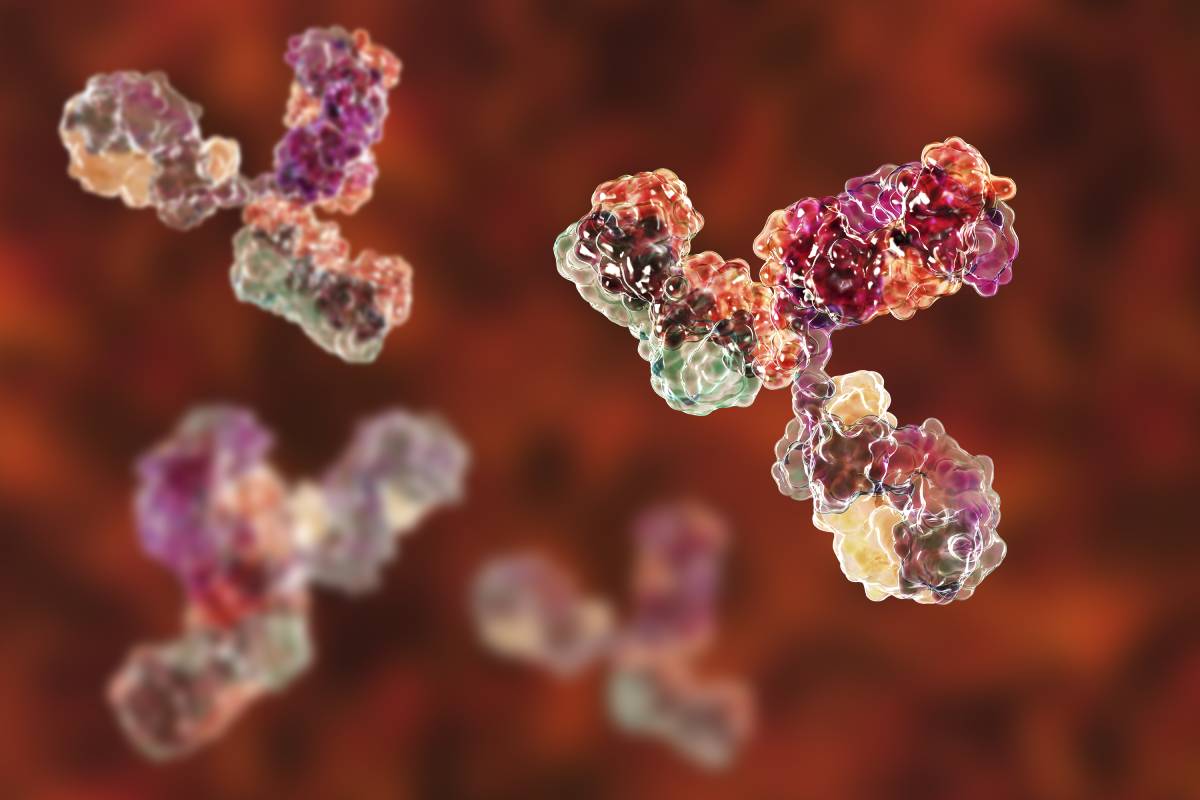Pioneered in the 1980s, monoclonal antibody therapy is a promising new form of immunotherapy that uses artificial immunoglobulin molecules (antibodies) to treat a wide array of conditions, including autoimmune diseases, cancer, plaque psoriasis, human immunodeficiency viruses (HIV), and COVID-19. Manufactured in labs, monoclonal antibodies (mAbs) fall into one of four categories based on their composition: murine (derived from mice), chimeric (derived from mice and humans), humanized (a small amount of mouse proteins mixed with human proteins), and human [1]. Each mAb protein can restore, enhance, or mimic the actions of natural antibodies by targeting specific antigens, such as the HER2 protein involved in metastatic breast cancer or the TNF protein involved in plaque psoriasis [2]. Natural antibodies are typically polyclonal, meaning they are produced by multiple types of B lymphocytes and therefore maintain different levels of specificity for their target, but monoclonal antibodies are generated from a single B lymphocyte clone, allowing each mAb to have an identical and strong specificity for their target [3]. Shortly after entering the body — typically via intravenous injection — mAbs bind to and attack their target antigen, which stimulates other antibodies to join the attack, with the effects lasting long after the initial administration [3]. Although some mAbs can attack their target antigen on their own, others are designed to carry medications, toxins, or radioactive substances to their target [2]. Each mAb works in its own unique way, but each of their mechanisms of action can be divided into two categories: one that requires the help of the immune system to induce cytotoxicity, and the other that works independently of the immune system to produce and manipulate cellular signals [3].
The former type of mAbs functions by recruiting various effector cells, including monocytes, granulocytes, macrophages, and natural killer (NK) cells, in order to induce lysis, killing the cell through a process known as antibody-dependent cellular toxicity (ADCC) [3]. Studies have shown that healthy levels of activated effector cells are required for this type of monoclonal antibody therapy to work effectively [4]. Another way mAbs use other components of the immune system is by binding the protein C1q to the target, triggering the classical complenent pathway and resulting in the formation of a membrane attack complex (MAC), thus causing lysis [5]. Stimulating this process — known as complement-mediated cytotoxicity — requires the recruitment of complement proteins and mAbs created with high specificity for their target.
The other type of mAbs can function effectively without the help of the immune system by producing and manipulating cellular signals [3]. Some of these mechanisms involve the binding of mAbs to the target surface, resulting in the disruption of cellular communication and leading to the release of a death signal and therefore apoptosis, as well as the prevention of angiogenesis [5]. Another mechanism entails the interference of target cell communication by blocking signals, removing the target from circulation, or obstructing the interaction between the target and its receptor through inhibiting the target-induced dimerization of the receptor or modulating the receptor itself [3]. As a result, the target cannot receive essential communication from its receptors, such as signals activating growth, resulting in the arrest and subsequent decay of the target [5].
Monoclonal antibody therapy presents encouraging results and has been applied to formerly “incurable” conditions such as cancer [6]. For example, the mAbs pertuzumab and trastuzumab have been shown to raise the median overall survival of patients with HER2-positive metastatic breast cancer by up to an astounding 57 months when used in combination with chemotherapy [7]; moreover, recent studies suggest that the use of the mAb sotrovimab or the combination of casirimivab and imdevimab successfully mitigates COVID-19 symptoms, reduces the risk of death and hospitalization by 60%, and decreases the amount of the virus circulating in an infected patient’s blood [8]. As the development of mAbs progresses, problems such as the production of anti-drug antibodies (ABAs) [9] will continue to be addressed, increasing the safety and efficacy of this treatment.
References
1: Meiller, J. (2016). What is a monoclonal antibody? National Institute for Cellular Biotechnology. Online article. URL: https://nicb.ie/biotechnology/what-is-a-monoclonal-antibody/.
2: Berger, M., Shankar, V., and Vafai, A. (2002). Therapeutic applications of monoclonal antibodies. American Journal of the Medical Sciences, vol. 324. DOI: 10.1097/00000441-200207000-00004.
3: Weiner, G. (2007). Monoclonal antibody mechanisms of action in cancer. Immunologic Research, vol 39. DOI: 10.1007/s12026-007-0073-4.
4: Van Ojik, H., Bevaart, L., Dahle, C., Bakker, A., Jansen, M., van Vugr, M., van de Winkel, J., and Weiner, G. (2003). CpG-A and B oligodeoxynucleotides enhance the efficacy of antibody therapy by activating different effector cell populations. Cancer Research, vol. 63. URL: https://cancerres.aacrjournals.org/content/63/17/5595.
5: Weiner, G. (2015). Building better monoclonal antibody-based therapeutics. Nature Reviews Cancer, vol. 15. DOI: 10.1038/nrc3930.
6: United States Food and Drug Administration (2021). Update: FDA authorizes additional monoclonal antibody for the treatment of COVID-19. FDA News Releases. Online report. URL: https://www.fda.gov/news-events/press-announcements/coronavirus-covid-19-update-fda-authorizes-additional-monoclonal-antibody-treatment-covid-19.
7: Costa, R. and Czerniecki, B. (2020). Clinical development of immunotherapies for HER2+ breast cancer: a review of HER2-directed monoclonal antibodies and beyond. NPJ Breast Cancer, vol. 6. DOI: 10.1038/s41523-020-0153-3.
8: Hydzik, A. and Sampsell, D. (2021). COVID-19 monoclonal antibody treatment reduces risk of hospitalization and death in UPMC patients. University of Pittsburgh Press Releases, online report. URL: upmc.com/media/news/051721-bariola-mab-ofid.
9: Vaisman-Mentesh, A., Rosenstein, S., Yavzori, M., Dror, Y., Fudim, E., Ungar, B., Koplov, U., Picard, O., Kigel, A., Ben-Horin, S., Benhar, I., and Wine, Y. (2019). Molecular landscape of anti-drug antibodies reveals the mechanism of the immune response following treatment with TNF-alpha antagonists. Frontiers of Immunology, vol. 10. DOI: 10.3389/fimmu.2019.02921.
